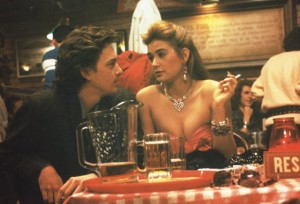High School is about conforming to the various groups and peers that surround you in the halls and classrooms every day. College is about finding yourself. Perhaps no other film to date has done a better job of showcasing the perils and tribulations of collegiate coeds that Joel Schumacher’s 1985 Brat Pack classic “St. Elmo’s Fire.”
Four months after graduating from Georgetown University, a group of friends get to observe firsthand the monumental differences between college and adult life. The gang is as diversified as one would expect from seven mid-twenties who leave their dorms at the top of the food chain only to find themselves starting all over again.
Kevin is an aspiring writer who has sworn off love for good, drawing the ire of his friends, and in particular his room mate Kirby, who is currently lusting after his treasured crush. “Love is an illusion.” Kevin morosely states, to which Kirby replies with the type of line you’d expect from this type of movie, “It’s the only illusion that counts my friend.”
Alec is a preppie type with an eye on a political career, who shocks his friends when he accepts a position working for the Republican Party. Leslie is Alec’s long time girlfriend whom he intends to marry, since that is what everyone would expect them to do.
Rounding out the group is wild partier Jules and forever frat boy Billy, both of whom seem to be hit the hardest in their attempts to adjust to life after college. “There’s no way to be out of hand in everyday life like you can in school.” Billy laments, as he still plays the role of the group clown.

“St. Elmo’s Fire” wins on the sheer power of its immense and truly ensemble cast, each actor owning each role in a seemingly flawless way. One area films sometimes fail is the reach of getting much older actors to portray high school or college students. Joel Schumacher and company do a perfect job of casting talent that are not only big names but all people that were of perfect age to be portraying recent college grads (with Mare Winningham as Wendy being the oldest member of the central cast at age 26).
In the years before television shows like Friends, “St. Elmo’s Fire” captures the raw emotions of young adults in a way like none other. In the absence of explosions and gunfights, dialogue and setting are everything.
Andrew McCarthy and Emilio Esteves offer perfect humor in the midst of a serious film, with McCarthy as the constantly dejected Kevin and Esteves as the love obsessed and over the top Kirby. “She’s not just a girl,” Kirby tells Kevin when describing a former older student he idolizes (Andie Macdowell) who doesn’t even know he exists. “She’s the only evidence of God I can find on this planet.” Characters like this aren’t only humorous, but highly relateable to the mainsream audience.
Stealing the show is Rob Lowe with his portrayal of Billy. The biggest train wreck of the group, Billy is probably the most insightful when it comes to living life to the fullest, and not selling out for anything. Billy, along with Jules (Demi Moore) have seemingly the toughest time letting go of the flare and fun of the college life.
One additional area where the film flourishes is the soundtrack, and specifically David Foster’s enchanting instrumental piece simply titled Love theme from St. Elmo’s Fire. The song is flat out beautiful and manages to convey the atmosphere of the story without a single word being uttered. The mesmerizing melody is distributed throughout the movie, with various parts played behind scenes they relate to the most. It makes the movie. In a word – genius.
While “St. Elmo’s Fire” is often overlooked for more popular and commercially successful 80s era films, thirty years after its release its a strong and powerful story that’s well written and superbly acted.
by – Matt Christopher